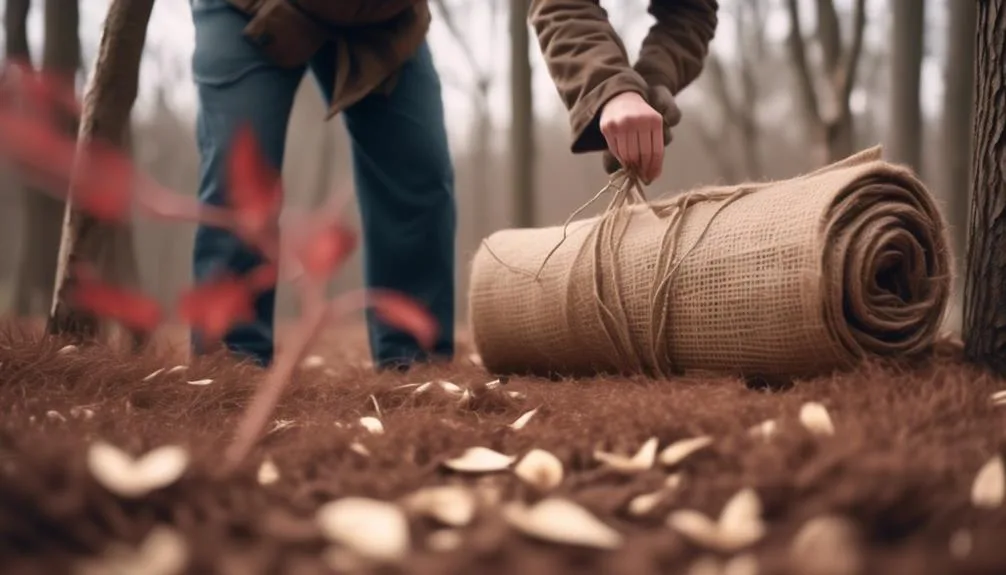As winter approaches, it's important to prepare your dogwood trees for the cold weather.
By taking a few simple steps, you can protect them from the harsh winter conditions and help them thrive when spring arrives.
This article will guide you through the essential measures to ensure your dogwood trees stay strong and beautiful throughout the winter months.
Pruning and Trimming
To prepare your dogwood trees for winter, carefully prune and trim any dead or diseased branches using sharp, clean tools to promote healthy growth and prevent winter damage. When pruning your dogwood trees, it's important to use proper pruning techniques to maintain the tree's natural shape and branch structure.
Start by identifying any dead or diseased branches, which are often discolored or brittle. Make clean cuts at a 45-degree angle just above a bud or lateral branch to encourage new growth. Additionally, thin out any crowded areas to improve air circulation and sunlight penetration.
Mulching and Watering
As you care for your dogwood trees, mulching and watering are essential practices to ensure their health and resilience through the winter months.
Mulching offers several benefits, such as insulation to protect the roots from extreme temperature fluctuations, moisture retention to keep the soil consistently damp, and weed suppression to prevent competition for water and nutrients. Apply a 2- to 4-inch layer of organic mulch, such as wood chips or shredded bark, around the base of the tree, extending it to the drip line.
When it comes to watering, it's crucial to establish a proper schedule. During the winter, dogwood trees still need moisture, especially during dry periods. Water deeply but infrequently, ensuring the soil remains moist but not waterlogged. Adjust the frequency based on weather conditions to maintain optimal soil moisture.
Protecting From Frost
During winter, protect your dogwood trees from frost by covering them with a breathable fabric or using frost cloth to shield them from freezing temperatures while still allowing air circulation. To effectively safeguard your dogwood trees, follow these steps:
- Insulating roots: Apply a thick layer of mulch around the base of the tree to insulate the roots and maintain a stable soil temperature.
- Covering branches: Wrap the trunk and lower branches with burlap or frost cloth to protect them from frost damage.
- Monitoring weather forecasts: Stay informed about upcoming frosts and take preemptive measures to protect your trees.
- Removing covers during the day: Uncover the trees during the day to allow sunlight and air circulation, then recover them at night to preserve warmth.
Wrapping for Winter
When preparing for winter, it's important to wrap the trunk and lower branches of your dogwood trees with burlap or frost cloth to shield them from freezing temperatures and prevent frost damage.
Insulating branches by wrapping them will create a barrier against harsh winter conditions, reducing the risk of ice damage.
Start by loosely wrapping the trunk with burlap, making sure to leave some space between the material and the bark to allow for air circulation.
Then, wrap the lower branches, working from the bottom up, and secure the material with twine.
This protective layer will help maintain a more stable temperature around the tree, shielding it from extreme cold and preventing ice damage.
Proper wrapping for winter ensures the continued health and vitality of your dogwood trees during the colder months.
Monitoring for Pests
Keep a close eye on your dogwood trees for any signs of pests, such as discoloration, wilting, or unusual holes in the leaves. Monitoring for pests is crucial to maintaining the health of your trees.
Here are some essential tips to help you effectively manage pests and prevent diseases:
- Regular Inspections: Check your dogwood trees regularly, especially during the growing season, to catch any pest infestations early.
- Proper Pruning: Remove and dispose of any dead or infested branches to prevent the spread of pests and diseases.
- Healthy Soil: Maintain good soil health and drainage to promote strong tree growth and resilience against pests.
- Natural Predators: Encourage natural predators like ladybugs or lacewings to help control pest populations without the use of harmful chemicals.
Conclusion
By tending to your dogwood trees with thoughtful care and attention during the winter months, you can ensure their health and vibrancy come spring.
Through pruning, mulching, protecting from frost, and monitoring for pests, you set the stage for a beautiful display of blossoms and foliage.
Embracing these simple steps will reward you with the joy of thriving dogwood trees in the seasons to come.

My interest in trees started when I first saw the giant sequoias in Yosemite.
I was a teenager then, and I remember thinking, “I need to learn more about this.”
That moment stuck with me.
A few years later, I went on to study forestry at Michigan Tech.
Since graduating, I’ve worked in a mix of hands-on tree care and community education.
I’ve spent over ten years helping people understand how to plant, maintain, and protect the trees in their neighborhoods.
I don’t see trees as just part of the landscape.
They are living things that make a real difference in our daily lives.
